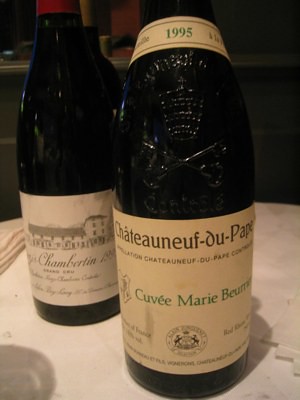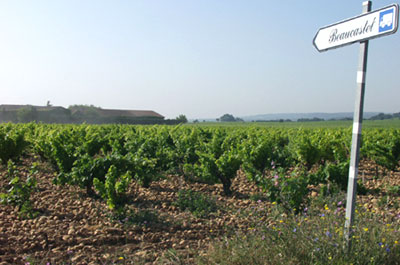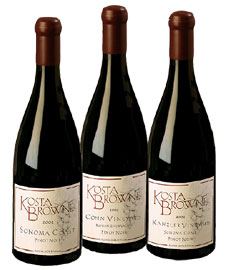 A vertical of mythic proportions…and then some, Bonneau on display
A vertical of mythic proportions…and then some, Bonneau on displayThe term ‘out of body experience’ seems as apt as any to describe the metaphysical sensations that tapdanced through the air during our vertical homage to Henri Bonneau at Tribeca Grill. I am certain that the sense of disarray we experienced is largely due to the formidably endowed, 17 plus percent alcohol that most vintages checked in at, but the evening was packed w/ much more than the fuzzy buzz that the booze provided. This group of Bonneau wines we sampled are some of the most singular, phenomenally constituted wines I’ve had the pleasure of tasting and certainly merit the legendary status they’ve already achieved.
Henri’s less than conventional methods of elevage (ranging from the unsanitary to the madly insane) are well documented, but still poorly understood. Whether or not Michel Roman is the heir apparent to the Bonneau throne, I couldn’t help but think that these types of wines will never be duplicated once Henri is no longer at the helm of his domaine. While tasting the tremendous ’90 Speciale, we broke into conversation about the 1947 Cheval Blanc (for reasons that I’ll elaborate on in the tasting notes), causing my mind to wander a bit. Will these wines become enological artifacts that cease to be reproduced in the squeaky clean, quality control oriented world of modern wine? When volatile acidity and residual sugar are looked at with almost universal disdain, how could anyone else but Henri Bonneau fashion a ’90 Speciale? What sane winery would release their product anywhere from 7 to 8 years after harvest, waiting for their wines, encased in filthy vats, to continue to ferment wildly, and unpredictably? While most winemakers I’ve spoken w/ freely admit that they are control freaks, who else would take the dramatic risk w/ Grenache, a varietal prone to oxidation, by letting it stew in the pot for that long? These are generally not things an oenophile would think of about a ‘living’ legend, but the passing of Robert Mondavi has forced me to acknowledge the industry’s great people while they are still breathing. I’ve become a bit of a softie, not unlike a young man who perilously gets involved with a femme fatale, who’s obviously over his head and certain to dump him at the drop of a hat. Better to have loved and lost they say….
Two quick points and then my fingers are off to the tasting note races:
- There are indisputable variances in these wines. There were two bottles of each the ’95 and ’92 Celestins that could not have been more different than one another. While one could argue the two lesser bottles were flawed to some extent (TCA, TBA or oxidation from a low fill), neither of the two bottles showed obvious contamination/oxidation signs, they were simply inferior examples. Several theories are possible; laissez faire bottling, deplorable cellar conditions, counter-fit bottles or a concept that I’d like to refer to as ‘Consequences of Extreme Grenache.’ I subscribe to the latter notion, simply because the envelope can only be pushed so far, especially w/ minimalist winemaking that isn’t exactly known for its stability. My experience and research w/ Grenache has lead me to believe that it has a tendency to behave in an erratic fashion in the bottle, which I’d imagine is amplified even more when the grape is pushed to its physiological limits of ripeness. The ’98 Celestins and ’03 Clos des Papes may prove to be classic examples of that phenomenon.
- The wine service at the Tribeca Grill is nothing short of superlative. David Gordon’s knowledgeable teams of sommeliers are as professional, attentive and passionate as any in all of New York. The only thing at Tribeca Grill that eclipses the quality of their service is their wine list; rivaling Mondragon’s famed Beaugraviere for the most breadth and depth of Chateauneuf du Pape wines across the globe. This is a stop that no Southern Rhone lover should miss when in New York City.
Now for the show….
Two gutsy blondes walked into the bar…
Grange des Peres ’01 Blanc 
My first taste of this cult-worthy Languedoc white was an impressive one and comparable in quality to their Cote Rotie-like reds that have also been received remarkably well. The nose is wildly exotic, w/ grilled nuts, apple marmalade, corn meal, fig, sea salt and wilted rose filling the air w/ an impressive array of the esoteric. In the mouth, the body turns a bit fat and heady, spliced w/ fiery minerality that lasers its way to the finish. The Roussanne aspect of the blend seems to be transitioning from flesh to flair, leaving the wine a bit awkward and disjointed, but with undeniable raw ingredients that should round out the recipe beautifully in 3 or so more years, 92 points.
Brocard Montmains Chablis, 2002
The scents of this young Chablis were as funky as any Chardonnay based wine that I can recall, as moldy cheese, jasmine, flint and ginger waft from the glass in an almost earthy presentation. The attack pirouettes w/ a complete 180, picking up some snappy citrus and quince flavors that dance along a racy spine, picking up steam on the finish. At the end of the day, it’s an off-kilter performance that wins many hearts at the conclusion, 90 points.
Bring on the beef:
1994 Chateauneuf du Pape
In the game of finding the illusive sweet spot of a wine’s evolution, this ’94 had to be at as close to its zenith as I can imagine. This rock solid ’94 opens w/ perfumes of lavender, freshly tilled earth, graphite and glazed mushrooms. A sweet attack of surprisingly primary kirsch and raspberry fruit glide along a fresh, medium toned frame and echo in easy persistence. As balanced and poised as Chateauneuf gets, minus the rocket propelled fireworks of the vintages to come, 90 points.
1992 Celestins
Out of the two bottles we opened, this was clearly the more youthful and vibrant; sporting scents of red cherry, olive paste, pipe tobacco and meat drippings. The palate is by no means blockbuster in weight, but is striking in its purity, pumping out juicy sun-kissed fruits along a gorgeous beam of minerality. The Celestins packed a bit more heft and intensity than the ’94 base cuvee, but certainly isn’t worth the price hike, 91 points. Can any ’92 Chateauneuf du Papes take this guy to task?
2000 Chateauneuf du Pape
This showed decidedly less variation (in relation to the ’00 I popped a couple weeks back) and is certainly a wine who’s potential for future development belies its orange-tinged ruby color. Sweet scents of balsamic, strawberry preserve, fried sausage, plum and brick dust greet the nose. A bit of VA and sur maturite actually goes a long way for this wine, which still manages to inject bright acidity into its extracted flesh, as an earthy edge keeps your interest on the mouthwatering finish. It will be interesting to see if this develops along the lines of the ’94, but it seems extremely precocious at this stage, 89+ points.
1995 Celestins
Again, this was clearly the best of two bottles, but its evolution before my eyes really had my head shaking. Initially it seemed like a barrel sample, w/ monstrous, dry port like intensity to the black cherry liqueur, peat moss, sage, tapenade, cedar and sweet ganache notes. Although this was a massive performance right out of the gates, there was an uncanny lift to the body, never allowing it to be top-heavy and always maintaining a sense of poise and symmetry. Surprisingly, it seemed to wane a bit in terms of intensity and it evolved a bit more than I would have expected over the hour or so it spent in the glass. In spite of the various curve balls, sound bottles of this should likely drink well over the next 5-10 years, 95 points.
1998 Celestins
Al and I concur that this is clearly not up to snuff when compared to the heights that this wine has achieved in past performances, perhaps surfacing a bit from the fore-mentioned ‘Extreme Grenache-ism Syndrome.’ There was a confectionary tone to this from the start, w/ blowzy scents of burnt licorice, fudge cake, brown sugar and hints of VA. While not unpleasant in the mouth, there was an intrusive acidity and oxidative note that seemed entirely out of place which marred this clumsy, over-ripe giant a bit more. While there were no noticeable contaminants, this brings to mind the Marcoux VV ’98 and Clos des Papes ’03 in terms of bizarre variants from otherwise classic quality wines, 77 points?
2000 Celestins
I don’t know how its possible, but this great vintage produced a luxury Bonneau cuvee that still seems ‘under the radar.’ This gem clearly demonstrates the exceptional ripeness of the vintage, but shows a bit more restraint and allure than I had thought it would bring to the table. Beguiling aromatics of iron, truffle oil, raspberry cream, fried pork and gravel shoot out from the glass w/ precision and verve. While extremely concentrated in the mouth, the  thickness and sinew has a remarkably coy sensibility. There is an almost flirty character to this wine, closing w/ a beam of rose petal and currant sauce flavors that just won’t quit. An absolute winner for Bonneau, whether or not he thinks it is ‘too tasty,’ 95 points.
thickness and sinew has a remarkably coy sensibility. There is an almost flirty character to this wine, closing w/ a beam of rose petal and currant sauce flavors that just won’t quit. An absolute winner for Bonneau, whether or not he thinks it is ‘too tasty,’ 95 points.
1999 Celestins
While just about every ’99 Chateauneuf I’ve tasted to this point has been quick to mature, this has to be the most compact and coiled wine of the vintage. Tight as a drum, but full of gorgeous hints of Asian spice, nutmeg, smoked meats and candied orange peel notes that make the knees buckle. Although the attack is supremely sweet, w/ copious fruits and an array of heavenly delights lurking in the background, the structure still has a firm grasp on the palate, pinning it down from totally bursting. This is a rare occasion in the vintage where the wine demands cellaring, 94+ points.
2001 Celestins
After our fears that this was a counter-fit bottle were assuaged (come on, there’s no way Bonneau released this yet, it’s only been 7 years!), we dove into Pandora’s box of all the devilish Grenache treasures one could ask for. The bouquet is crammed to the gills w/ bloody beef, crushed flowers, super-ripe kirsch liqueur and just about anything one would hope for in supremely decadent Chateauneuf du Pape. The mouthfeel is absolutely outrageous, cutting a broad swath across the palate w/ ferocious intensity, drive and persistence. While only an infant, the quality of this vintage is undeniable as this is one hedonistic thrill-ride, as the jaw-dropping levels of extract reverberate on the palate for well over a minute. Buckle up your seatbelts for this one folks, 98 points!
Now here comes the Helen of Troy flight, certainly one to launch a thousand ships packed w/ drooling wine geeks:
1990 Marie Beurrier
Well, she had some stacked competition, but to be totally honest, this was my darkhorse surprise of the evening and a complete revelation in terms of how great a ‘lower tier cuvee’ can performa in a stellar vintage. An absolutely gorgeous nose broods from the glass with hearty plum sauce, lead pencil shavings, sweet tobacco and kirsch liqueur notes. The entry is sappy and decadent, paving the way for an immensely rich palate, exploding w/ tiers of spicy, unadulterated layers of fruit. The wine is fabulously textured and as generous as a top vintage of Celestins. This certainly would shock even the most experienced of Chateauneuf tasters in any blind line-up and owners of this bottle will likely enjoy another 5 plus years of top notch drinking from this vintage…thanks again for bringing this David, 95 points.
1990 Celestins
As far as reputations go, this bottle carried the loftiest expectations, and those expectations were met by the nose but fell a bit short in the mouth. A field of ambrosia was paved by the bouquet of black forest cake, menthol, warm ganache and fresh fig that I could have sit and sniffed all evening. In the mouth, while the wine was frankly concentrated, it lacked the depth and length of what I would consider a perfect wine. As it sat in the glass, the ’90 picked up some steam and started to flesh out a bit more, suggesting this will continue to cruise in the cellar & could benefit from a more generous decant, 96+ points.
1990 Speciale
Bonneau has only made the Speciale cuvee twice, the other declared vintage being 1998. While all of Henri’s wines are late harvest Grenache, this is a REALLY late harvest Grenache that even the most ferocious of yeasts couldn’t ferment dry, even after three years of trying! The wine must be close to 17 percent natural alcohol, and while there was supposedly 3 grams of residual sugar when it was bottled, it appears time has begun to convert this dessert wine into an outrageously compelling table wine. Easily the darkest, most opaque color of the flight, the nose is nothing short of remarkable, w/ luxurious notes of roast beef, date bread, truffle butter, freshly cut cedar, brandy soaked raspberries and spice cake flavors roaring from the glass. In the mouth, the wine simply has to be tasted to be believed, as it is incredibly opulent, thick and jam-packed w/ surreal layers that express the essence of old vine Grenache. Although it hits you over a head w/ a sledgehammer, the frame of the wine somehow keeps everything shapely and far from ponderous. Once this elixir traveled down the gullet, the sensual kiss of a finish must have lingered for close to 90 seconds. Bound to be a legend and possibly immortal Chateauneuf, I would extend the drinking window well into the middle of this century and I think owners of this wine will thank their lucky stars that they’ve held onto such an other worldly bottle when they finally decide to dive in, 100 points.
Chris brought up discussion of the ’47 Cheval Blanc when we popped the ’90 Speciale because it was a wine that was r iddled w/ similar flaws at birth such as excessive alcohol (well, not quite at this level, but you get the point), volatile acidity, residual sugar and lord knows what else. Chris tasted this upon released and considered it to be more of a freak show than anything, but was shocked at how it has evolved in a more ‘normalizing’ fashion that anything (he would have bought a lot more had he known, damnit!). When coupling all these notorious flaws together in the right proportion (which seems an almost impossible feat to replicate, unless you have access to the magical ‘Bonneau pixie dust’ that he sprinkles in his moldy barrels), they seem to synthesize wines of uncanny longevity as well as character. Looking at each ‘flaw’ they are actually preservatives of sorts (Riesling fans are certain to be familiar w/ the wonders of what a bit of residual sugar can do in the cellar) & I believe wines that create this type of oxymoron (‘flawed perfection’) are the ones that get not only lusted over at auction, but deified over the wine-geek fireplace for years to come. Chris, I can’t thank you enough for allowing us to dive into this marvel of modern enology…but since you’ve raised the bar so high, I expect that ’89 Rayas you bring next time to really shine!
iddled w/ similar flaws at birth such as excessive alcohol (well, not quite at this level, but you get the point), volatile acidity, residual sugar and lord knows what else. Chris tasted this upon released and considered it to be more of a freak show than anything, but was shocked at how it has evolved in a more ‘normalizing’ fashion that anything (he would have bought a lot more had he known, damnit!). When coupling all these notorious flaws together in the right proportion (which seems an almost impossible feat to replicate, unless you have access to the magical ‘Bonneau pixie dust’ that he sprinkles in his moldy barrels), they seem to synthesize wines of uncanny longevity as well as character. Looking at each ‘flaw’ they are actually preservatives of sorts (Riesling fans are certain to be familiar w/ the wonders of what a bit of residual sugar can do in the cellar) & I believe wines that create this type of oxymoron (‘flawed perfection’) are the ones that get not only lusted over at auction, but deified over the wine-geek fireplace for years to come. Chris, I can’t thank you enough for allowing us to dive into this marvel of modern enology…but since you’ve raised the bar so high, I expect that ’89 Rayas you bring next time to really shine!





























